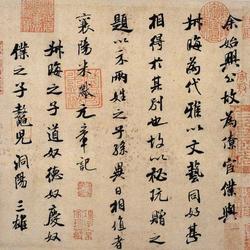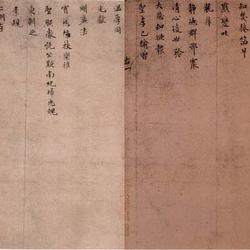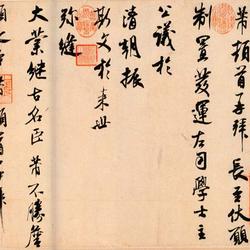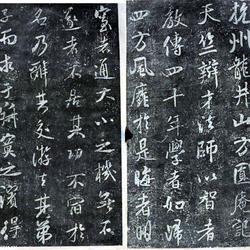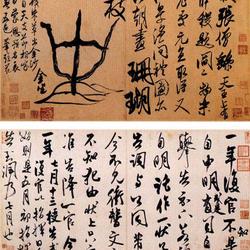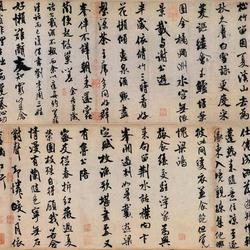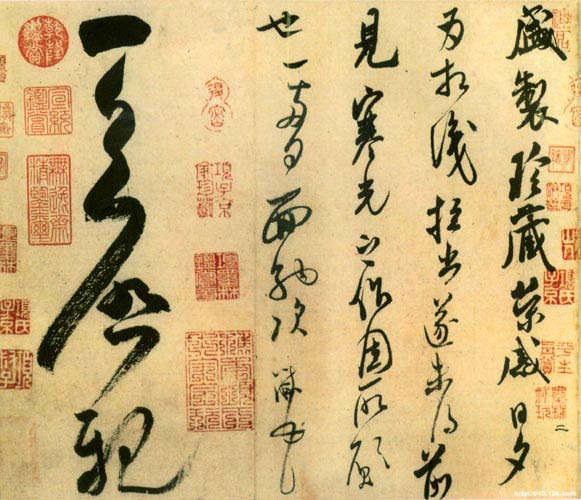
Mi Fu's "Sheng Zhi Tie", cursive calligraphy ink, 27.4 cm in length and 32.4 cm in width, collected by the Palace Museum in Beijing. About the fifth year of Yuanfeng (1082)
Explanation:
A grand collection, a sense of honor. Day and night
Pulled out for acquaintance, but failed to get ahead
See the work of cold light, solidify your wish
Also, one or two days of face-to-face payment, with a pause.
Apocalypse dear.
illustrate;
This is a letter to Cai Zhao.
Cai Tianqi (Cai Zhao), a native of Danyang, Runzhou, learned from Wang Anshi and Su Shi successively.
This post is from the time when I went to Jinling in the fifth year of Yuanfeng, and the host was banished because he met Wang Anshi. At this time, Tianqi was studying at Zhongshan from Jinggong. The host here refers to Liu Xiang. Therefore, we know that this post is rice. It was written in Jinling in the fifth year of Yuanfeng.
In the sixth year of Yuanfeng (1083 AD), Mi Fu went to Jinling to seek a job in Jinling due to Liu Xiang's recommendation, but failed. At this time, when Wang Anshi was exiled to Zhongshan in Jinling, Mi Fu wrote poems Wen Zhi saw that Jiefu praised others for his work, but he admired Mi's poems and essays, and discussed calligraphy with him. After seeing Wang Jinggong's calligraphy, Mi Fu identified the calligraphy he was inspired by by Yang Ningshi, a contemporary calligrapher. Wang was greatly impressed by the influence and said, "No one knows about it." At this time, Mi Fu was only thirty-three years old, but his amazing appreciation ability had already appeared. After Mi Fu's death, Cai Zhao, the author of his "epitaph", was also here. We met at that time, Gai Cai was a member of the king's family, and he was under the tent at that time.
Supplement: Liu Xiang, Yanzi of the Song Dynasty, courtesy name Xidao, was ranked as a Jinshi. The Yingzong asked for outspokenness, Xiang wrote to discuss current affairs, in addition to supervising the behavior of the censor, the emperor did not hesitate, the heir was not correct, Xiang Shuying, the king was long and virtuous, and it was appropriate to envoy The Emperor was imprisoned. Shenzong was established and moved to the right to advise. He knew Kaifeng Mansion all the time. Wang Anshi wanted to see him, but he refused to go. He discussed the new law and did not attach it to Anshi. Yuanyou was added to the privy council for the first time, and he knew that Weizhou died and Xiang died. If there are officials who are capable, they can understand the history of the past dynasties, and Anshi will call them knowledgeable.
Art appreciation:
Because it is a letter, it has a very elegant character. I read it through the notes, alternating cursive lines with each other, and the more I write, the more energetic I become.
Starting from the first line, it is written in running script, and then it is mainly written in cursive. The writing is fast and astringent, and the roundness is smooth but not floating. When writing to the word "黻尊头", there is not much ink on the tip of the pen. , the meaning of the writing is like a gossamer, like a butterfly playing with a flower, or a dragonfly flicking in the water. However, although the thing is clearly stated, the meaning is not yet exhausted, and the empty paper is still there, so the pen is filled with ink and the ink is full, and it is swaying as much as possible until the three characters of "天奇情" stand majestically. His madness, eccentricities, and wanton behavior are all before his eyes.
Looking closely at the entire work, the fonts in the first line and the last three lines are inconsistent. The four characters "Shengzhi Collection" reveal that this work should give people the feeling of extending outwards but with some deliberate brushstrokes; while the words "Glory to the Sun and Evening" are not It is written with a letter pen, with a continuous and smooth feeling. The more you write, the smoother and smoother it becomes. At the end of the stroke, "Fu Dun Shu" is brought up with one stroke, and the last stroke is lifted up and added, making the whole work fuller and full of meaning. Outer leakage. Although the first four characters give people a sense of solemnity and caution, the four characters "honorful day and night" harmonize the upper and lower moods. The speed from slow to fast reveals Mi Fu's unfinished mood when he writes freely, making it more free and unrestrained. The three characters "Tianqi Qin" were written. Later there was a postscript by Dong Qichang: "This ruler of Lao Mi seems to have been made by Cai Tianqi, and the wonderful shape of the calligraphy and ink can be seen here."
Overall, this post contains a lot of details and interesting ideas.

